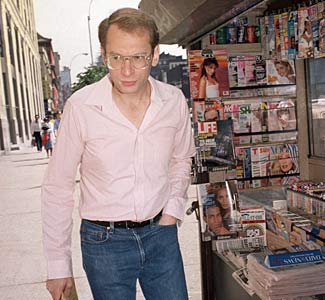 |
| Trayvon Martin's biggest crime consisted of looking like a crowd extra from Law & Order |
I can’t help remembering the highly publicized Bernard Goetz case. For those too young to remember, or not up on history, on December 22nd, 1984, Goetz, who had been mugged previously, used an unregistered revolver to shoot four black youths on a Manhattan subway who he claimed tried to rob him. After nine days on the run, the man the papers dubbed “The Subway Vigilante” turned himself in, and eventually served eight months on a minor gun charge.
Unlike Zimmerman, who faces near-universal hatred, Goetz became almost a folk hero. Because New York subways had become nearly synonymous with crime in a notoriously crime-riddled city, one man’s refusal to knuckle under transformed him into a potent symbol for gun ownership and civilian justice. But because a white man shot four black kids, he also embodied the racial divides that have long lingered beneath Manhattan’s urbane veneer.
Both shooters packed guns and, by all evidence, went out in search of a confrontation. Both sought to make a statement, and both became national figures for reasons that would probably not make their mothers proud. Yet where Goetz attracted heated controversy, with both supporters and detractors, Zimmerman has only shirt-tail support. And the difference is striking.
 |
| To this day, Bernard Goetz remains a hero to some, a villain to others |
Perhaps the divergent reactions have something to do with the relative locations each shooter struck. People don’t associate Sanford, Florida, with the kind of crime that permeated Ed Koch’s New York. Indeed, Florida attracts copious retirees in large part because crime remains localized, and limited to drug and white collar infractions. Random muggings are rare enough to attract statewide attention. So Zimmerman seems considerably less justified that Goetz.
But the problem is not regional. In the two decades before Goetz’s attack, American crime rates had skyrocketed. New York crime had nearly tripled, and was not only nearly twice as high as the nation in general, but was one of the highest in the world. Watching the Subway Vigilante hit back seemed downright justified in light of the fact that ordinary working New Yorkers walked in fear for their lives every time they used mass transit.
We can’t say the same in 2012. Since 1993, crime has trended consistently downward. Despite regional outbursts and occasional sprees, the last two decades have seen America become as safe as it has been in living memory. Goetz’s Manhattan, once an icon of lawlessness, is now a family-friendly tourist attraction. George Zimmerman’s Sanford, Florida, is so bucolic that Kenny Chesney used it as a backdrop in the video for his nostalgic song “Young.”
Goetz and Zimmerman broke the law, but under disparate circumstances. While some called Goetz a criminal, and he did stand trial for his actions, he also gave people hope that criminals wouldn’t always run America’s cities. Though morally shaky, Goetz’s actions looked heroic. Zimmerman’s actions look like the jittery outbursts of a nut fueled by Red Bull, paranoia, and half-digested online conspiracy theories.
 |
| A Kel-Tec PF-9, the variety of easily concealed pistol George Zimmerman used to shoot Trayvon Martin |
Hopefully, as tragic as Trayvon Martin’s death is, it will energize our nation to distinguish real, legitimate fears from gibbering paranoia. Bernard Goetz had a legitimate fear, and if he didn’t handle it well, he at least handled it in a germane way. Here’s hoping George Zimmerman represents the dying gasp of an outmoded avenue of thought.
My hometown of Stockton, California, where I still have family, is currently one of the most dangerous places in 'The Golden State'. And yet, contrasted against the almost daily shootings, regular nightly gunfire, a police department that's understaffed by one-third and a city torn apart by gang violence and near bankruptcy, the 'news of the day' is all about a 163', $43 million dollar yacht a local millionaire recently decided to dock downtown. My point being that, while we should never stop reminding people of the past and hoping "outmoded avenue(s) of thought" will become just that, yesterday's travesties still have a way of reinventing themselves across the next hill, sea or other real or manufactured divide.
ReplyDeleteBoth Trayvon and George made serious errors of judgement. Trayvon's criminal record and comments aren't too inspiring either. Once George was getting his skull bounced on the pavement, without some fantastic counter evidence, self-defense is clear.
ReplyDeleteWhat you say about self-defense, Anonymous, is true. But it cuts both ways. If getting pummeled by an unarmed assailant justifies self-defense, what then is justified by getting chased through the streets by a stranger with a gun?
ReplyDeleteSince Trayvon Martin had a legitimate reason to be where he was, had to weapons, and was targeted BEFORE attempting to defend himself, I fail to see what errors of judgment he made.